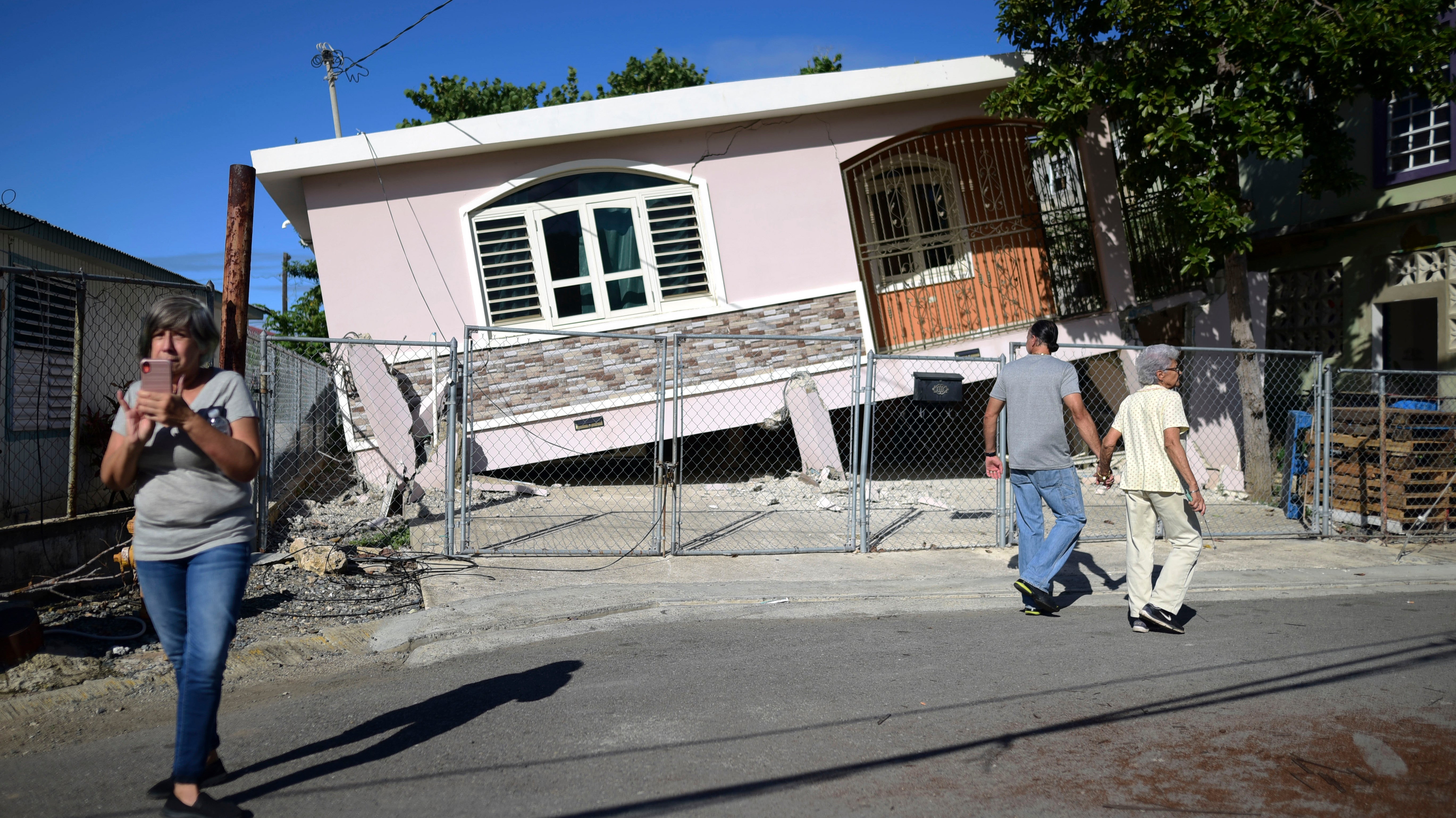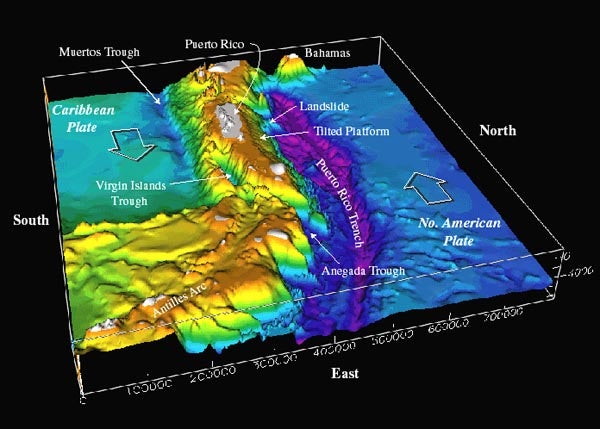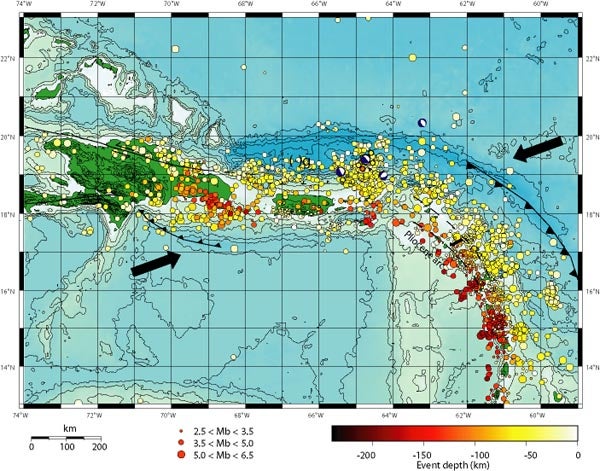Earthquake Shows How Fragile Puerto Rico's Electric Grid Still Is
Yessenia Funes
1/6/2020 3:55PM
Filed to:PUERTO RICO

The power of Monday’s earthquake.Photo: AP
Puerto Rico just can’t seem to catch a break. The people of the island have been dealing with a series of small earthquakes for about a week, but the situation worsened Monday when a 5.8 magnitude earthquake shook the southwest part of the island early morning.
The quake was strong enough to knock out power for thousands of people in the southern part of the island. This latest incident is just a reminder of how fragile the electrical grid in Puerto Rico remains since Hurricane Maria hit more than two years ago. The storm ripped the island’s grid apart, leading to the worst in U.S. history. And the island still has a long way to go before ensuring that another months-long power outage doesn’t occur following a natural disaster.
Before Monday’s 5.8-magnitude earthquake, smaller ones averaging around magnitude 4.6 had been shaking the island. While the larger shake luckily didn’t result in any reported deaths or injuries, at least five homes in Guánica were left damaged as a result, according to El Nuevo Dia. Punta Ventana, a stone arch hailed for its natural wonder on the island, fell apart due to the earthquake.
Hurricane Maria Left Thousands of Puerto Rican Children Experiencing Symptoms of PTSD, Survey
Hurricane Maria was the deadliest storm in modern U.S. history. And the damage didn’t end when the…Read more
The island is “fairly seismically active,” Wendy Bohon, a geologist with the Incorporated Research Institutions for Seismology, told Earther, but the current level of activity is a bit unusual. Puerto Rico rests in between two tectonic plates: the Caribbean Plate and North American Plate. Wherever these boundaries exist in the world, seismological activity follows because the rubbing of tectonic plates is what creates earthquakes in the first place. However, now that a larger earthquake has rattled the island, smaller aftershocks are sure to follow. And there’s always the small chance of a larger earthquake, instead.
“The people of Puerto Rico have had a long night,” Bohon told Earther. “They’ve had a long couple of days, and it’s not going to end yet.”
It appears the Puerto Rican Electric Power Authority shut down a couple of power substations during the earthquake, per El Nuevo Dia. Still, power hasn’t been restored to affected communities, many of which are scarred by the last time they were left without power.
“That’s one of the things we try and stress when we talk to government officials,” Bohon said. “Maintaining strong infrastructure in the face of these disasters is critical. It’s also very, very difficult.”
What makes it all the harder in Puerto Rico is the lack of funds to properly address the island’s infrastructure, which was already in rough shape even before Maria hit. The Federal Emergency Management Agency has funded only 2 percent of the roughly 9,000 financial requests for long-term recovery projects on the island, according to the New York Times. The Trump administration delayed the appropriations of billions of dollars worth of recovery aid to the island even as Texas and Florida have seen thousands of projects receive the aid necessary to begin recovery after Hurricane Harvey and Hurricane Michael respectively. Then, there’s the Department of Housing and Urban Development, which illegally withheld relief dollars meant to help the island.
Now, Puerto Rico remains in basically the same state it was in more than two years ago right before Hurricane Maria hit.
Federico de Jesús, a senior adviser to the coalition Power 4 Puerto Rico, was visiting family on the island when the earthquake hit. He awoke to everything in his room shaking. He told Earther he felt like he was in a boat. What worries him the most about these earthquakes is the risk a tsunami could pose.
Roberto Garcia, the meteorologist-in-charge at the San Juan National Weather Service office, told Earther Hurricane Maria left many of these systems damaged. It’s unclear how many have been fixed or restored since then. Each municipality is responsible for its own system, and the sirens are not a federal requirement. Still, de Jesús worries that “if there was a tsunami, we wouldn’t find out.
“Thank God that there wasn’t, but that goes to show how the infrastructure here is still so fragile after Maria, and there’s still so much to be done to make sure that Puerto Rico is ready for any type of natural disaster: hurricane, earthquake, or otherwise.”
So far, the types of earthquakes hitting the coast of Puerto Rico aren’t the type that create tsunamis, Bohon said. The plates have been sliding past each other in these recent events. In order for a tsunami to occur, the tectonic plates must push upward and lift the seafloor, which is what causes the waves to rise.
These days, unfortunately, the island doesn’t need a tsunami to lose power. It doesn’t need much, in fact. And when power is lost, many vulnerable individuals—including survivors of domestic violence, those who rely on respiratory machines and refrigeration for medicine, and people who are deaf—suffer disproportionately. They’re already dealing with a ton of shit as is, but the darkness only makes it worse.
“There are so many pockets of vulnerable people. This just ripples out in a way that people don’t understand,” Erica Gonzalez, the director of Power for Puerto Rico, told Earther. “Among the concerns are that people who are already vulnerable to begin with, that we saw super impacted after Hurricanes Irma and Maria, are going to be affected again.”
MORE FROM EARTHER
Indonesia Turns to Weather Control to Stop Rains Amidst Deadly Floods
Satellite Images Show the Shocking Extent of Australia Bushfire Smoke
Trump's 'Tremendous Work' on Superfund Sites Includes Not Funding Their Cleanup
Here's Every Project Being Delayed to Pay For President Trump's Idiotic Border Wall
ABOUT THE AUTHOR
Yessenia Funes
Senior staff writer, Earther. The one who "pulls the race card" in the name of environmental justice. You dig?

 Dense non aqueous phase liquid >Yessenia Funes
Dense non aqueous phase liquid >Yessenia Funes
1/06/20 7:41pm
From a USGS geology type via NOAA:
The Puerto Rico Trench: Implications for Plate Tectonics and Earthquake and Tsunami

Figure 1. Bathymetry of the northeast corner of the Caribbean plate. The main topographic features of this area include: the Lesser Antilles volcanic arc, the old inactive volcanic arc of the Greater Antilles (Virgin Islands to Hispaniola), and the Caribbean and North American oceanic plates. Note that the Puerto Rico Trench, a deep trough where the North American plate slides past and underneath the Antilles, becomes deeper and wider north of Puerto Rico. A limestone platform is tilted toward the trough in this area. Other large-scale features are the Muertos Trough, where Caribbean plate crust may slide under the Antilles, and the Virgin Islands and Anegada Trough, whose origin is unknown. Image courtesy of USGS .



Figure 2. Location of earthquakes as a function of depth and size in the northeastern Caribbean. Barbed lines represent subduction zones; arrows represent the direction of relative plate motion; dashed lines represent migration of the line of volcanoes from an older line to a newer one farther west; and (-)g represents the location of the largest minimum gravity anomaly on Earth.

Puerto Rico just can’t seem to catch a break. The people of the island have been dealing with a series of small earthquakes for about a week, but the situation worsened Monday when a 5.8 magnitude earthquake shook the southwest part of the island early morning.
The quake was strong enough to knock out power for thousands of people in the southern part of the island. This latest incident is just a reminder of how fragile the electrical grid in Puerto Rico remains since Hurricane Maria hit more than two years ago. The storm ripped the island’s grid apart, leading to the worst in U.S. history. And the island still has a long way to go before ensuring that another months-long power outage doesn’t occur following a natural disaster.
Before Monday’s 5.8-magnitude earthquake, smaller ones averaging around magnitude 4.6 had been shaking the island. While the larger shake luckily didn’t result in any reported deaths or injuries, at least five homes in Guánica were left damaged as a result, according to El Nuevo Dia. Punta Ventana, a stone arch hailed for its natural wonder on the island, fell apart due to the earthquake.
Hurricane Maria Left Thousands of Puerto Rican Children Experiencing Symptoms of PTSD, Survey
Hurricane Maria was the deadliest storm in modern U.S. history. And the damage didn’t end when the…Read more
The island is “fairly seismically active,” Wendy Bohon, a geologist with the Incorporated Research Institutions for Seismology, told Earther, but the current level of activity is a bit unusual. Puerto Rico rests in between two tectonic plates: the Caribbean Plate and North American Plate. Wherever these boundaries exist in the world, seismological activity follows because the rubbing of tectonic plates is what creates earthquakes in the first place. However, now that a larger earthquake has rattled the island, smaller aftershocks are sure to follow. And there’s always the small chance of a larger earthquake, instead.
“The people of Puerto Rico have had a long night,” Bohon told Earther. “They’ve had a long couple of days, and it’s not going to end yet.”
It appears the Puerto Rican Electric Power Authority shut down a couple of power substations during the earthquake, per El Nuevo Dia. Still, power hasn’t been restored to affected communities, many of which are scarred by the last time they were left without power.
“That’s one of the things we try and stress when we talk to government officials,” Bohon said. “Maintaining strong infrastructure in the face of these disasters is critical. It’s also very, very difficult.”
What makes it all the harder in Puerto Rico is the lack of funds to properly address the island’s infrastructure, which was already in rough shape even before Maria hit. The Federal Emergency Management Agency has funded only 2 percent of the roughly 9,000 financial requests for long-term recovery projects on the island, according to the New York Times. The Trump administration delayed the appropriations of billions of dollars worth of recovery aid to the island even as Texas and Florida have seen thousands of projects receive the aid necessary to begin recovery after Hurricane Harvey and Hurricane Michael respectively. Then, there’s the Department of Housing and Urban Development, which illegally withheld relief dollars meant to help the island.
Now, Puerto Rico remains in basically the same state it was in more than two years ago right before Hurricane Maria hit.
Federico de Jesús, a senior adviser to the coalition Power 4 Puerto Rico, was visiting family on the island when the earthquake hit. He awoke to everything in his room shaking. He told Earther he felt like he was in a boat. What worries him the most about these earthquakes is the risk a tsunami could pose.
Roberto Garcia, the meteorologist-in-charge at the San Juan National Weather Service office, told Earther Hurricane Maria left many of these systems damaged. It’s unclear how many have been fixed or restored since then. Each municipality is responsible for its own system, and the sirens are not a federal requirement. Still, de Jesús worries that “if there was a tsunami, we wouldn’t find out.
“Thank God that there wasn’t, but that goes to show how the infrastructure here is still so fragile after Maria, and there’s still so much to be done to make sure that Puerto Rico is ready for any type of natural disaster: hurricane, earthquake, or otherwise.”
So far, the types of earthquakes hitting the coast of Puerto Rico aren’t the type that create tsunamis, Bohon said. The plates have been sliding past each other in these recent events. In order for a tsunami to occur, the tectonic plates must push upward and lift the seafloor, which is what causes the waves to rise.
These days, unfortunately, the island doesn’t need a tsunami to lose power. It doesn’t need much, in fact. And when power is lost, many vulnerable individuals—including survivors of domestic violence, those who rely on respiratory machines and refrigeration for medicine, and people who are deaf—suffer disproportionately. They’re already dealing with a ton of shit as is, but the darkness only makes it worse.
“There are so many pockets of vulnerable people. This just ripples out in a way that people don’t understand,” Erica Gonzalez, the director of Power for Puerto Rico, told Earther. “Among the concerns are that people who are already vulnerable to begin with, that we saw super impacted after Hurricanes Irma and Maria, are going to be affected again.”
MORE FROM EARTHER
Indonesia Turns to Weather Control to Stop Rains Amidst Deadly Floods
Satellite Images Show the Shocking Extent of Australia Bushfire Smoke
Trump's 'Tremendous Work' on Superfund Sites Includes Not Funding Their Cleanup
Here's Every Project Being Delayed to Pay For President Trump's Idiotic Border Wall
ABOUT THE AUTHOR
Yessenia Funes
Senior staff writer, Earther. The one who "pulls the race card" in the name of environmental justice. You dig?

 Dense non aqueous phase liquid >Yessenia Funes
Dense non aqueous phase liquid >Yessenia Funes1/06/20 7:41pm
From a USGS geology type via NOAA:
The Puerto Rico Trench: Implications for Plate Tectonics and Earthquake and Tsunami

Figure 1. Bathymetry of the northeast corner of the Caribbean plate. The main topographic features of this area include: the Lesser Antilles volcanic arc, the old inactive volcanic arc of the Greater Antilles (Virgin Islands to Hispaniola), and the Caribbean and North American oceanic plates. Note that the Puerto Rico Trench, a deep trough where the North American plate slides past and underneath the Antilles, becomes deeper and wider north of Puerto Rico. A limestone platform is tilted toward the trough in this area. Other large-scale features are the Muertos Trough, where Caribbean plate crust may slide under the Antilles, and the Virgin Islands and Anegada Trough, whose origin is unknown. Image courtesy of USGS .

Figure 2. Location of earthquakes as a function of depth and size in the northeastern Caribbean. Barbed lines represent subduction zones; arrows represent the direction of relative plate motion; dashed lines represent migration of the line of volcanoes from an older line to a newer one farther west; and (-)g represents the location of the largest minimum gravity anomaly on Earth.
No comments:
Post a Comment